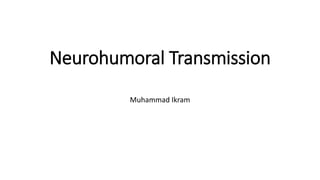
Neurohumoral Transmission.pptx
- 2. Meaning of Neurohumoral Transmission (NHT): Neurohumoral transmission refers to the transmission of impulse through synapse and neuro-effector junction by the release of humoral (chemical) substances. The term ‘conduction’ stands for the passage of an impulse along an axon or muscle fiber. Almost all autonomic drugs, which are used clinically, exert their pharmacological actions by altering essential steps in the neurohumoral transmission process.
- 3. The principal neurotransmitters released from the postganglionic sympathetic and parasympathetic nerve endings respectively are noradrenaline (NA or norepinephrine, NE) and acetylcholine (ACh), whereas the transmitter released in ganglia from the preganglionic nerve ending of both systems is acetylcholine. There are a number of other neurotransmitters, which are called as non-adrenergic non- cholinergic (NANC) transmitters, released from the specific nerve endings. Those include nitric oxide, serotonin (5- HT), ATP, dopamine, GABA, purines, peptides etc.
- 5. Physiological Steps Involved In NHT The events involved in NHT at synapses and neuro-effector junctions can be divided into axonal conduction, synthesis and release of neurotransmitters, receptor events and destruction of the neurotransmitters.
- 6. Axonal Conduction After receiving an information from a peripheral organ through sensory nerve, CNS sends message or impulse through efferent autonomic nerves. A message or impulse is nothing but the state of depolarization which is propagated through the nerve fibers for transmission of information through it. In normal resting state, a nerve cell is approximately -70 mV negative inside to the outside. This is ‘resting membrane potential’ of a typical mammalian axon. At rest, the Na+ concentration is high at extracellular space and low in intracellular fluid. Whereas the concentration of K+ ion is nearly 40-fold higher in axoplasm than the extracellular fluid.
- 7. Though the K+ ions can cross the resting axonal membrane, but Na+ ions are not permeable through the membrane. These ionic gradients or the resting membrane potential is maintained by an energy- dependent active transport or pump mechanism- called the Na+ – K+– ATPase or Na+– K+ pump which helps in efflux of 3 molecules of Na+ and influx of 2 molecules of K+ ions through the membrane. Stimulation or arrival of an electrical impulse to a nerve fiber causes a sudden increase in Na+ permeability. Na+ enters into the fiber through Na+ channels and thereby increases the positivity (depolarization) inside the fiber even up to + 20 mV (overshoot).
- 8. K+ ions then move out of the fibre in the direction of their concentration gradient to repolarize the area. Ionic distribution is normalized and the resting membrane potential is reestablished by the activation of Na+ – K+ pump. The events of Na+ influx, depolarization, K+ efflux, repolarization in a shorter form, is termed as action potential, An action potential, thus generated by a stimulus or arrival of an electrical impulse to a nerve fiber, up local circuit currents which activate voltage sensitive Na+ channels at the next excitable part of the membrane and an impulse or action potential is propagated through a nerve fiber in this way.
- 9. Tetrodotoxin and saxitoxin selectively prevent the increase in permeability to Na+ and thus block axonal conduction and produces flaccid type of paralysis. Batrachotoxin and scorpion toxins selectively increase Na+ permeability to cause persistent depolarization which results in spastic paralysis. Local anaesthetics interfere with the Na+ permeability and block axonal conduction.
- 10. Transmission through Ganglia and Neuro-effector Junctions Once an action potential arrives at the axonal terminal a number of sequential events take place. The depolarization of the area leads to stimulation and opening of the voltage sensitive Ca+ channels of axonal membrane. Ca+ enters into the axoplasm and helps in fusion between the axoplasmic membrane and synaptic vesicles which are the store houses of neurotransmitters (excitatory or inhibitory), enzymes and some other proteins. The contents of those vesicles are then extruded out to the junctional cleft by a process called exocytosis.
- 11. This neurally mediated release can be modulated by the transmitter itself or by other agents through interaction with the pre-junctional membrane receptors. Norepinephrine (NE, through α2 adrenoceptors), dopamine, acetylcholine (through M2 receptors), adenosine, enkephalins and prostaglandins inhibit NE release. Whereas acetylcholine (through N receptors) and isoprenaline (β2 receptors) accelerate the NE release. Similarly, the neurally mediated ACh release from cholinergic neurons (not in ganglia or skeletal muscle) is inhibited by α2 adrenergic and muscarinic agonists.
- 12. Receptor events on post-junctional membrane: The released transmitters rapidly migrate across the cleft and bind with specific receptors on the post junctional neuronal or effector cell membrane (Fig. 16.1). The excitatory neurotransmitters bind with their receptors resulting in increase in Na+ permeability which causes depolarization followed by K+ efflux or repolarization. These changes are characterized as an “excitatory post-synaptic potential (EPSP)” which helps in either propagation of impulse through the post-ganglionic neurone or stimulation of effector organs (e.g., contraction of smooth muscles or secretion of glands).
- 13. Similarly, inhibitory neurotransmitters bind with their respective receptors to increase the permeability of K+ and CI– which move in the direction of their concentration gradients (K+ efflux and CP influx) resulting in hyperpolarization (increased negativity inside the cell). These changes are termed as an “inhibitory post synaptic potential (IPSP)” which stabilizes the post-synaptic membrane increasing the threshold to stimuli and elicits an inhibitory response in the cell (Fig. 16.1).
- 15. During the resting state, small amount of neurotransmitter is released slowly but continuously from the nerve ending. Though the amount is not sufficient to elicit a response but produces electrical potential at the post-junctional membrane (“miniature endplate potential”, MEPP) that maintains the normal sensitivity of the effector organ to neurotransmitter.
- 16. Fate of Neurotransmitters: A maximum percentage of adrenergic neurotransmitter norepinephrine either reenters into the presynaptic presynaptic nerve terminal (uptake I) or diffuses away from the receptor sites (uptake II). Rest amount is metabolized by both intra-neural (MAO) and extra-neural (COMT) enzymes. The released ACh is rapidly hydrolyzed by acetyl-cholinesterase (AChE) enzyme that normally localizes in the synaptic cleft.